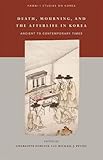Death, Mourning, and the Afterlife in Korea : Ancient to Contemporary Times / ed. by Charlotte Horlyck, Min Sun Kim, Michael J. Pettid.
Material type: TextSeries: Hawai'i Studies on KoreaPublisher: Honolulu : University of Hawaii Press, [2014]Copyright date: ©2014Description: 1 online resource (288 p.) : 21 illustrationsContent type:
TextSeries: Hawai'i Studies on KoreaPublisher: Honolulu : University of Hawaii Press, [2014]Copyright date: ©2014Description: 1 online resource (288 p.) : 21 illustrationsContent type: - 9780824839680
- 9780824840150
- 393.9 23
- GT3286.K6 D43 2016
- online - DeGruyter
- Issued also in print.
| Item type | Current library | Call number | URL | Status | Notes | Barcode | |
|---|---|---|---|---|---|---|---|
 eBook
eBook
|
Biblioteca "Angelicum" Pont. Univ. S.Tommaso d'Aquino Nuvola online | online - DeGruyter (Browse shelf(Opens below)) | Online access | Not for loan (Accesso limitato) | Accesso per gli utenti autorizzati / Access for authorized users | (dgr)9780824840150 |
Frontmatter -- Contents -- Acknowledgments -- Note on Names, Terms, and Titles -- Chronology -- 1. Considerations on Death in the Korean Context -- Part I. The Body -- 2. Death and Burial in Medieval Korea: The Buddhist Legacy -- 3. Making Death "Modern": Reevaluating the Patient's Body, Transforming Medical Practice, and Reforming Public Health at Seoul National University Hospital, 1957-1977 -- Part II. Disposal -- 4. Ways of Burial in Koryŏ Times -- 5. Death as a Nationalist Text: Reading the National Cemetery of South Korea -- Part III. Ancestral Worship and Rites -- 6. Shamanic Rites for the Dead in Chosŏn Korea -- 7. The Familiar Dead: The Creation of an Intimate Afterlife in Early Chosŏn Korea -- Part IV. Afterlife -- 8. Ghostly Encounters: Perceptions of Death and the Afterlife in Koryŏ and Early Chosŏn -- 9 Buddhism and Death In Kim Man-Jung's a Nine Cloud Dream: From Fact to Fiction, and Nowhere Back Again -- 10. Dying for Heaven: Persecution, Martyrdom, and Family in the Early Korean Catholic Church -- Bibliography -- Contributors -- Index
restricted access online access with authorization star
http://purl.org/coar/access_right/c_16ec
Death and the activities and beliefs surrounding it can teach us much about the ideals and cultures of the living. While biologically death is an end to physical life, this break is not quite so apparent in its mental and spiritual aspects. Indeed, the influence of the dead over the living is sometimes much greater than before death. This volume takes a multidisciplinary approach in an effort to provide a fuller understanding of both historic and contemporary practices linked with death in Korea. Contributors from Korea and the West incorporate the approaches of archaeology, history, literature, religion, and anthropology in addressing a number of topics organized around issues of the body, disposal of remains, ancestor worship and rites, and the afterlife. The first two chapters explore the ways in which bodies of the dying and the dead were dealt with from the Greater Silla Kingdom (668-935) to the mid-twentieth century. Grave construction and goods, cemeteries, and memorial monuments in the Koryŏ (918-1392) and the twentieth century are then discussed, followed by a consideration of ancestral rites and worship, which have formed an inseparable part of Korean mortuary customs since premodern times. Chapters address the need to appease the dead both in shamanic and Confucians contexts. The final section of the book examines the treatment of the dead and how the state of death has been perceived. Ghost stories provide important insight into how death was interpreted by common people in the Koryŏ and Chosŏn (1392-1910) while nonconformist narratives of death such as the seventeenth-century romantic novel Kuunmong point to a clear conflict between Buddhist thought and practice and official Neo-Confucian doctrine. Keeping with unendorsed views on death, the final chapter explores how death and the afterlife were understood by early Korean Catholics of the eighteenth and nineteenth centuries. Death, Mourning, and the Afterlife in Korea fills a significant gap in studies on Korean society and culture as well as on East Asian mortuary practices. By approaching its topic from a variety of disciplines and extending its historical reach to cover both premodern and modern Korea, it is an important resource for scholars and students in a variety of fields.
Issued also in print.
Mode of access: Internet via World Wide Web.
In English.
Description based on online resource; title from PDF title page (publisher's Web site, viewed 02. Mrz 2022)


